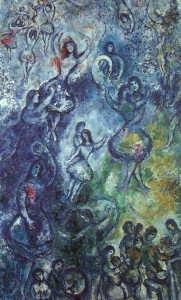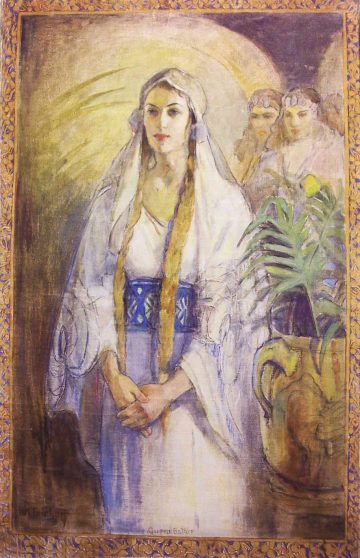 I love that the Church has a variety of images available to help supplement lessons. Whether it be Gospel Doctrine or Primary, I want to make sure the whole class gets to see a woman and hear her story every Sunday I teach, so these pictures of Eve, Miriam, Mary (any Mary), Ruth or Esther* feel like old friends to me.
I love that the Church has a variety of images available to help supplement lessons. Whether it be Gospel Doctrine or Primary, I want to make sure the whole class gets to see a woman and hear her story every Sunday I teach, so these pictures of Eve, Miriam, Mary (any Mary), Ruth or Esther* feel like old friends to me.
Because of the Church’s copyrights for these pieces of art, I can’t put them in this post, but I hope you’ll take moment and look at them. (Maybe open each one in a new tab as you read this blog post.)
By having a variety of women depicted from all four sacred books of scripture, LDS.org’s Gospel Art section is making an important statement: women matter and are a part of our religious history. And, every time I check back, the overall collection grows as do the pieces that showcase women. But, when I look at this collection as a whole, I see some damaging messages being sent. One of concern is the narrow range of emotions women express in these paintings. We see women looking unsure, confused or in the depths of despair. In fact, the only times women look happy, content or confident is when they are embodying traditional gender roles.
The downtrodden appear most in the Church History section. While I appreciate that these women are shown in the trenches, they’re all unnamed. As they cross the plains and bury their dead, we see their despair. Huddled in rags with wind blowing, their eyes are usually half-closed or completely closed with expressions of pain clearly visible.
In fact, there are only two that don’t convey explicit hardship and both are of Emma. One is her portrait and the other depicts the founding of Relief Society. Her portrait shows a woman relatively peaceful and content. The founding of Relief Society painting is a rather beatific view of Joseph speaking to a group of women in the glow of morning sunlight. Emma stands, prominently placed at his side, but she’s not the focus and she looks more stoic than peaceful, holding her skirts.
These pictures are a good start. I’m glad Emma has two pictures, and though most are unnamed, it is commendable that the Church History section of art keeps expanding the collection and adding more depictions of women. But, more can be done. We have this history, we know the names of the Relief Society presidents and their stories. The Church History art section can be added to provide supplemental material to Daughters in My Kingdom. These women and their stories can be found in books like Women of Covenant and Women of Faith in the Latter-Days. Adding depictions of other women would, I think, also help counteract another problem I noticed.
The only places we see the range of women’s emotions expanded is in the New and Old Testament art collections. When women are engaged in traditional gender roles, i.e. serving a man in some way, their expressions show confidence or contentment. Rebekah confidently pours Abraham’s servant water, and Martha, after being chastised, still looks content as she stirs her bowl. The one of the only times a woman is the focus of a painting, looking serene, occurs when a pregnant Mary rides the donkey to Bethlehem with Joseph guiding the animal.
This trend continues as we look at the two depictions of Eve in the collection. First, Eve is sitting with Adam, teaching her children, and looking content in this idylic scene. But, the other picture has her watching Adam, who is praying at the alter. She looks at Adam, who is the only one actively communicating with God, and Eve looks unsure, as if she is in need of being taught how to have her own relationship with God. These pictures create a concerning juxtaposition and seem to send the message that when a woman is engaged in domestic work, she is content. But, when it comes to important religious matters, it’s best to leave the leading to the men.
 We know that Rebeka, Martha, and Eve did far more than their gendered portrayals suggest. Rebekah was a valued and intelligent partner with Isaac, Martha is only one of two people in the New Testament to bravely declare that Jesus was the Son of God while he still lived, and without Eve, there would be nothing but the Garden of Eden.
We know that Rebeka, Martha, and Eve did far more than their gendered portrayals suggest. Rebekah was a valued and intelligent partner with Isaac, Martha is only one of two people in the New Testament to bravely declare that Jesus was the Son of God while he still lived, and without Eve, there would be nothing but the Garden of Eden.
Even though I am fond of this painting of Miriam and use it often in Primary, she is put in the traditional gendered role of a young girl as the faithful babysitter, watching over Baby Moses. What if we expanded the collection to include Marc Chagall’s Miriam (see right). They confidently lead this dance and the joy these women show, celebrating their safe passage through the Red Sea is an emotion I hope to see in the Gospel Art collection as it expands.
 While there is copyright and acquistions to contend with, I don’t believe it would be difficult to find pieces that depict women as strong, spiritual leaders. I see it already exists in Rose Datoc Dall’s Three Days of Esther (see left). In this painting, we see Esther’s spiritual transformation from the throes of deep prayer and meditation until her final day, where she stands confidently, having made her decision on her own. This is the model I want the young women of the Church to see over and over again.
While there is copyright and acquistions to contend with, I don’t believe it would be difficult to find pieces that depict women as strong, spiritual leaders. I see it already exists in Rose Datoc Dall’s Three Days of Esther (see left). In this painting, we see Esther’s spiritual transformation from the throes of deep prayer and meditation until her final day, where she stands confidently, having made her decision on her own. This is the model I want the young women of the Church to see over and over again.
We show pivotal events of men’s spiritual growth, like Joseph Smith in the Sacred Grove or Lehi and Nephi using the Liahona (I do give extra points to the artist for the thoughtful women standing in the foreground on the left). We can do the same for women. Instead of Sariah leaning on Lehi, relegated to the background or missing altogether, what would happen if we had a picture of Sariah teaching her sons as we see Joseph teaching Jesus or saw her praying as fervently as Moroni?
I imagine the LDS.org Gospel Art collection showing Ruth boldly proclaim, “Whither thou goest, I will go,” in addition to this depiction that shows hard and humbling work of she did as a gleaner. I long for depictions of women like Abish, who’s images are not readily found. By taking the time and making the effort to add depictions of women exhibiting strength and confidence, we, as a Church, can show that women and their spiritual experiences are as valued as men’s.
*Minerva Teichert’s Esther watercolor had been available on lds.org before, but I notice it now isn’t there.






26 Responses
I know I am biased, but this is seriously insightful stuff. I won’t be looking at church art the same. What a great medium to draw out the hidden role of patriarchy and prove the argument that even a patriarchy of love still subjugates and marginalizes women.
Even more impressive is using this medium as a window into the relationship between the church and the feminine over time. I would love to see a comparison of pre and post-correlation church art depicting women.
Are you planning on doing more on this topic?
Thanks, Naters. I’ll take your biased praise (since our children watched so much tv while I wrote this). I have a couple more sections that I’ve saved them for another time because the blog post was getting too long.
This is really interesting. I don’t spend much time on LDS.org, but know that I think about it, most Mormon art puts women in traditional gendered positions, even though many of those positions have nothing to do with the stories told about them, or make no sense in a historical context. Thanks for sharing. I”ll need to think about this.
I was surprised too, DG. I have looked at so many of these images all my life and it wasn’t until I looked at the collections that I saw the problems.
I love this post, Emily! This has been something I’ve been passionate about for quite sometime now. Our girls and young women need to see women of the scriptures/church used in lessons and prominently displayed in our buildings. Just recently I had a victory in this area: Our Stake President recently ordered a number of Minerva Teichert paintings for the Stake office. The first counselor is a friend of mine and he showed me the paintings, asking where I thought they should go in the stake waiting room. I sighed and said that it is a shame that these wonderful pictures should be in a room where only a very few people would see and enjoy them. I said the one of Jesus blessing the children should be where the Primary kids can see it. The one of Mary and Martha should be in the Relief Society room and most definitely the one of Esther should be right outside of the YW room where my girls could look at it as they congregate by the doors each Sunday. I stated that most of the pictures up in our stake center were dark and drab– we had two, one of Adam Ondi Ahman and another of Hill Cumorah which no one would know what they were without reading the tiny engraved tag at the bottom of the frame.
To my surprise, a few weeks later, the beautiful face of Esther greeted me as I walked to my YW classrooms! (For some this may seem a small victory, but you take what you can in a very conservative area!)
I would love to have prints like the Chagall and the Dall in our buildings as well. I like going to the Museum of Church History and Art in Salt Lake because there are unique pieces that I think would be great additions to the standard LDS gospel art kit. This is another reason I love the Exponent magazine. Every issue has wonderful, vibrant art to lift the soul and enliven the mind.
What a great victory, Kirsten! I’m so glad your shared it here.
Since searching for art for EXII, I often wish such pieces like we see in the Museum of Church History and Art (love that place!) and have in the magazine were easier to purchase and hang in our ward buildings.
Have you ever taken a look at the artwork by Elspeth Young. I find her images absolutely beautiful because they capture the different personalities of all the women in the scriptures. Here’s the web address to her online collection, http://www.alyoung.com/art/elspeth_young.html. (One of my favorites is the one of the prophetess Huldah called “Treasure the Word”).
Thanks for that link, some beautiful artwork there!
I have seen Elspeth Young’s work before. The breadth of women in the scriptures and Church history she has done is truly inspiring.
Thank you for reminding me of her work, Erin!
This is really fascinating, Emily. I never really thought about LDS art in this way. It makes me wish I were an artist, so I could create the strong female images I would love to see. There has been a surge of writing on the topic of women in the scriptures and in LDS history, as you say. It would be wonderful to see LDS painters do the same.
Me, too, Catherine, me, too! I suppose I’ll just continue harassing all the artists I know…that’s my talent 🙂
This is such a great post. It makes me think of my sister who is going to Snow College on an art scholarship. She is very much a tomboy, loves shooting guns and is proud of the muscles she has from throwing pots on the potter’s wheel. I wonder if she’d be up to depicting women and their spiritual strength in her artwork someday.
Snow has such a great art program. Clearly, there is lots of creative talent in your family.
If she (or any other artists reading this) are interested, EXII is always looking for art and artists to feature. Email us at editorATexponentiiDOTorg (please!).
This is amazing, EmilyCC. Thank you for bringing it to light; I do wonder if the church even realises the bias or if it was an inadvertent sin of omission. Just recently, I searched LDS online distribution for lithographs with images of women and/ or children to decorate some girls’ bedrooms. I ended up very disappointed with the limited choices… it is a shame to be forced to search outside of LDS art just to find better and increased number of spiritually strong female images.
In addition, I was searching for church colouring pages for girls. I found this link http://ldscoloringpages.net/ that has all of the colouring pages from the Friend… you can see in the summary descriptions that females are depicted very rarely, and often in position to male leadership. So—even something as innocent and simple as colouring pages for children are tainted in regard to depicting women in a strong, spiritual light.
It is sad, isn’t it, spunky? I’ve only ordered temple pictures and a Jesus one for my kids’ room.
Maybe someday I’ll get around to hanging them. So far, I haven’t seen much else that I want to hang. Have you?
Wow. Thanks for taking the time to put this together. Really thoughtful analysis. I have two pieces of religious art in my home: Botticelli’s “Mary” and this amazing piece by Minerva Teichert:
http://bit.ly/LWlnI1
It’s from 3 Nephi 17. All the angels are women (some bearing fruit baskets) and they look *joyful*. I didn’t quite realize how rare this is . . .
I have seen that Minerva Teichert one before, but I didn’t know the scripture that went with it. That makes it even more wonderful!
I so, so love Minerva Teichert’s work — have you seen the Book of Mormon with her illustrations? It’s beautiful, and somehow it changes things.
Oh my heavens! I haven’t, but I think I’ll have to find myself a copy.
Thank you for this post. I remember being frustrated when I could not find a picture of Anna and the baby Jesus when teaching primary. When my son was asked to give a talk on missionaries in primary I wanted both male and female examples. He gave his talk on Ammon and Abish. I found lots of pictures of Ammon, but I had to use a generic “lamanite girl” picture in place of Abish. It is so important for these kids to see and hear these stories. After my son gave his talk one of the older primary boys came up and told him that he’d never heard of Abish. He was really excited about her story.
Ok, I’m totally stealing that idea the next time my kids are giving a talk, Hopeful. Thanks!
I came across your blog and found it very interesting. I have to share two artist’s work Annie Henrie, a young artist who has several awesome paintings that I think express some of the sentiment of your post (anniehenrie.com) and Lynde Mott (lyndemott.com) who has many painting of church history that depict actual historical women celebrating sisterhood. Of course neither one is featured in the Gospel Art Libarary but that is true of many of the contemporary LDS currently being created.
MatthewC, thanks for your comment. We published some of Annie’s work in our Winter 2011 issue. I love her work.
But, I hadn’t seen Lynde’s before. I’ll definitely be bugging her.
Thanks again!
Wonderful thoughts! I’ve thought the same thing many times – and the more we talk about it – the better chance we’ll have of seeing more women in pictures in the future.
This is such a thoughtful critique of the church art collection. I would like to add a suggestion for action. This applies to photos of modern Mormons, not renderings of scriptural ones, but I still think this is a great way that we can improve the church’s collection of images of women. The church now invites any member to submit quality photos to the church media library. Wouldn’t it be great if some of the talented photographers who read the Exponent submitted images of women in community and church leadership roles, that illustrate women as leaders? The details about how to submit images are here: http://www.lds.org/service/volunteer-and-contribute/create/photos/get-involved?lang=eng
I didn’t realize that, April. What an accessible (and powerful) way to improve the collection!